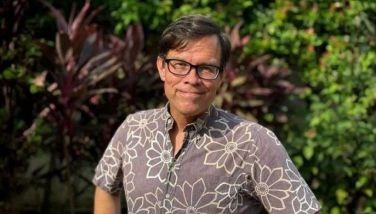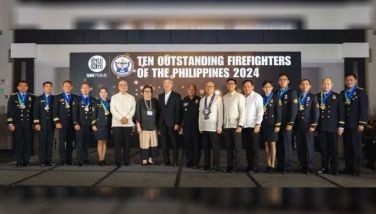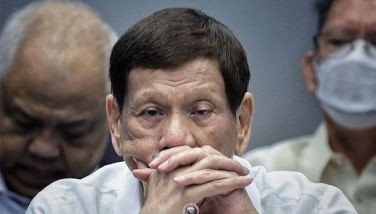Arroyo: Heads will roll
May 27, 2003 | 12:00am
President Arroyo, describing Sunday’s ferry-passenger boat collision that claimed 25 lives as "another black eye in maritime safety," vowed yesterday that heads will soon roll.
She gave the Department of Transportation and Communications (DOTC) 14 days to pinpoint responsibility for the collision that led to the sinking of the M/V San Nicolas and submit a report to her office.
With sea transportation a fundamental aspect of the Philippine economy, the President vowed that "heads will roll."
Officials speculated that crew incompetence caused the accident.
"These mishaps annoy me," Mrs. Arroyo said in a speech at Malacañang.
"I’d like to issue a warning to our maritime authorities about the strict enforcement of navigational rules and the fitness of pilots of commercial vessels. These perennial accidents must be stopped," she said.
The President visited the headquarters of the Philippine Coast Guard (PCG) in Manila Sunday night to sympathize with survivors and relatives of those who died in the accident.
"We’ll be filing civil, administrative and criminal proceedings against those who would be found liable for this disaster," Transportation and Communications Secretary Leandro Mendoza said.
He added that the Board of Marine Inquiry had started the investigation Sunday night and is expected to issue a recommendation within 15 days.
"The ax will fall and there will definitely be no sacred cows here," Mendoza said, assuring the public that the government will penalize those liable for the accident.
However, he said that as of yesterday, authorities have not determined the real cause of the sea tragedy.
Navy officials said at least 25 people drowned and an unknown number were missing after the wooden-hulled San Nicolas collided with the much larger passenger ship, the SuperFerry 12, and sank off Corregidor island on Sunday morning.
The San Nicolas smashed into SuperFerry 12 in poor visibility as it entered Manila Bay from Coron island in western Palawan.
Though the owners of both ships claimed they were on course, PCG commander Vice Adm. Reuben Lista quoted survivors as saying the San Nicolas hit the SuperFerry on its left (port) side and was dragged after getting snagged on a metal boarding ladder.
He said the ships, going in opposite directions, were supposed to pass each other on their right (starboard) sides.
Mendoza said the two skippers "did not understand each other" and that both turned left to try to avoid colliding, suggesting a communication breakdown may have helped cause the accident.
Defense Secretary Angelo Reyes, concurrent head of the Office of Civil Defense, suggested that officers on both vessels had maneuvered to avoid a head-on collision amid a tropical storm.
"The maneuver was not executed perfectly," he said on ABS-CBN television, citing preliminary testimony from the San Nicolas captain, who survived.
Reyes said the San Nicolas captain "admitted he was the one who more or less drove into the SuperFerry 12."
"They should have been forewarned earlier about the coming of each other. I understand, too, that the visibility was quite impaired," he said.
Other officials, however, said the visibility was about three kilometers at the time.
Reyes said the search effort should continue over the next three days.
As a storm lashed the western coast of Luzon early Monday, Coast Guard and naval vessels as well as private ships combed the Manila Bay waters for possible survivors.
"They are double-checking, just in case some passengers are afloat near the collision site," Coast Guard spokesman Lt. Armando Balilo said on government radio.
He said authorities suspected the San Nicolas carried more passengers than its maximum capacity because the number of survivors and dead so far recovered are more than the 158 passengers and 28 crewmen listed on its manifest.
Rescuers found 25 bodies and plucked 203 survivors from the choppy waters, but with strong winds and heavy rain battering the scene, they gave up hope yesterday that more survivors would be found.
"We are interviewing the survivors to determine how many more are missing," Balilo said. "The vessel had sunk to the sea floor at a depth beyond the capability of the rescuers."
Some of the SuperFerry 12’s 1,506 passengers said they were not aware of the collision until their ship dropped inflatable life rafts. The vessel returned to Manila without sustaining casualties or major damage.
Small boats and ferries, notorious for overloading and lacking safety features, are the chief means of travel among islands in the Philippine archipelago, where boat accidents are common and four in 10 residents live on less than a dollar a day.
The Philippines was the site of the world’s worst peacetime maritime disaster when the Doña Paz ferry sank after colliding with a fuel tanker off central Mindoro island in December 1987, killing 4,340 people. In May last year, 19 were killed when an overloaded ferry capsized. Another 44 died a month earlier when an inter-island vessel caught fire. — With AFP
She gave the Department of Transportation and Communications (DOTC) 14 days to pinpoint responsibility for the collision that led to the sinking of the M/V San Nicolas and submit a report to her office.
With sea transportation a fundamental aspect of the Philippine economy, the President vowed that "heads will roll."
Officials speculated that crew incompetence caused the accident.
"These mishaps annoy me," Mrs. Arroyo said in a speech at Malacañang.
"I’d like to issue a warning to our maritime authorities about the strict enforcement of navigational rules and the fitness of pilots of commercial vessels. These perennial accidents must be stopped," she said.
The President visited the headquarters of the Philippine Coast Guard (PCG) in Manila Sunday night to sympathize with survivors and relatives of those who died in the accident.
"We’ll be filing civil, administrative and criminal proceedings against those who would be found liable for this disaster," Transportation and Communications Secretary Leandro Mendoza said.
He added that the Board of Marine Inquiry had started the investigation Sunday night and is expected to issue a recommendation within 15 days.
"The ax will fall and there will definitely be no sacred cows here," Mendoza said, assuring the public that the government will penalize those liable for the accident.
However, he said that as of yesterday, authorities have not determined the real cause of the sea tragedy.
Navy officials said at least 25 people drowned and an unknown number were missing after the wooden-hulled San Nicolas collided with the much larger passenger ship, the SuperFerry 12, and sank off Corregidor island on Sunday morning.
The San Nicolas smashed into SuperFerry 12 in poor visibility as it entered Manila Bay from Coron island in western Palawan.
Though the owners of both ships claimed they were on course, PCG commander Vice Adm. Reuben Lista quoted survivors as saying the San Nicolas hit the SuperFerry on its left (port) side and was dragged after getting snagged on a metal boarding ladder.
He said the ships, going in opposite directions, were supposed to pass each other on their right (starboard) sides.
Mendoza said the two skippers "did not understand each other" and that both turned left to try to avoid colliding, suggesting a communication breakdown may have helped cause the accident.
Defense Secretary Angelo Reyes, concurrent head of the Office of Civil Defense, suggested that officers on both vessels had maneuvered to avoid a head-on collision amid a tropical storm.
"The maneuver was not executed perfectly," he said on ABS-CBN television, citing preliminary testimony from the San Nicolas captain, who survived.
Reyes said the San Nicolas captain "admitted he was the one who more or less drove into the SuperFerry 12."
"They should have been forewarned earlier about the coming of each other. I understand, too, that the visibility was quite impaired," he said.
Other officials, however, said the visibility was about three kilometers at the time.
Reyes said the search effort should continue over the next three days.
As a storm lashed the western coast of Luzon early Monday, Coast Guard and naval vessels as well as private ships combed the Manila Bay waters for possible survivors.
"They are double-checking, just in case some passengers are afloat near the collision site," Coast Guard spokesman Lt. Armando Balilo said on government radio.
He said authorities suspected the San Nicolas carried more passengers than its maximum capacity because the number of survivors and dead so far recovered are more than the 158 passengers and 28 crewmen listed on its manifest.
Rescuers found 25 bodies and plucked 203 survivors from the choppy waters, but with strong winds and heavy rain battering the scene, they gave up hope yesterday that more survivors would be found.
"We are interviewing the survivors to determine how many more are missing," Balilo said. "The vessel had sunk to the sea floor at a depth beyond the capability of the rescuers."
Some of the SuperFerry 12’s 1,506 passengers said they were not aware of the collision until their ship dropped inflatable life rafts. The vessel returned to Manila without sustaining casualties or major damage.
Small boats and ferries, notorious for overloading and lacking safety features, are the chief means of travel among islands in the Philippine archipelago, where boat accidents are common and four in 10 residents live on less than a dollar a day.
The Philippines was the site of the world’s worst peacetime maritime disaster when the Doña Paz ferry sank after colliding with a fuel tanker off central Mindoro island in December 1987, killing 4,340 people. In May last year, 19 were killed when an overloaded ferry capsized. Another 44 died a month earlier when an inter-island vessel caught fire. — With AFP
BrandSpace Articles
<
>
- Latest
- Trending
Trending
Latest
Trending
Latest
Recommended
































